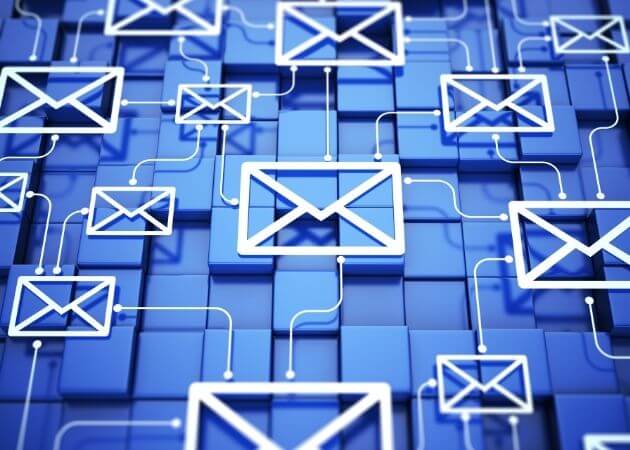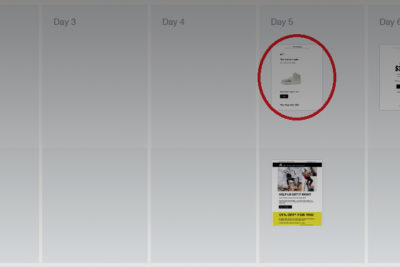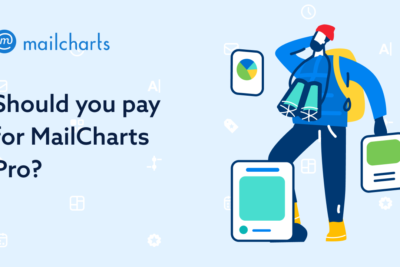A healthy store is a store that sells to both new and old customers. Unfortunately, what brings someone to your website won’t necessarily get them to buy, and the incentive that makes them sign up for your email list doesn’t automatically turn them into a loyal customer either.
You need to meet people where they’re at and guide them through every stage of the customer lifecycle. Email lifecycle campaigns are a great tool for this and we’ll explore just what they consist of and which type of campaigns need to be part of your lifecycle email marketing.
But first, let’s have a look at what exactly lifecycle marketing is.
What is Lifecycle Marketing?
Lifecycle marketing nurtures (potential) customers so that they become more likely to buy and turn into repeat customers. It guides them through the different stages of the customer lifecycle, from being someone who’s unaware of your brand to someone who’s a loyal customer.
Different marketers may use slightly different terms to talk about the various stages of the customer lifecycle, but they can be summarized as:
- awareness: the prospect learns about your brand and products.
- engagement: they start interaction with you. For example, by signing up to your email list.
- conversion: they buy their first product from your store.
- fulfillment: they are informed about the status of their order, receive their order, and are asked about their experience.
- loyalty: the more often they have a positive conversion and fulfillment experience, the higher the chances of them becoming a loyal customer.
Marketers have a variety of channels at their disposal to reach customers at various stages within the customer journey, but email is the one that truly stands out. Email marketing allows you to communicate directly with your subscribers in a mostly automated way while being able to track how they engage with your emails at every stage of the customer lifecycle.
Components of an Email Lifecycle Campaign
Lifecycle email marketing consists of sending automated emails or a series of emails following an action taken by a subscriber or customer. This action is the trigger that sets off the email journey or lifecycle campaign. It is one of five critical components you need when building an email journey.
All five components are:
1. The behavioral trigger:
The most popular journey triggers are when an email subscriber signs up, abandons their cart, purchases a product, browses, or cancels a subscription. Other types of triggers can include when a customer hasn’t ordered anything for a certain period of time, when a subscriber hasn’t opened your emails in a few months, or when someone registers for your loyalty program.
2. The wait period:
This is the time you let pass between the triggering action and sending the first triggered email.
3. The number of emails:
Each email lifecycle campaign consists of a certain number of emails. There is no set rule about how many emails a specific journey type should have but some types of journeys work better as a longer sequence than others.
When welcoming a new subscriber, for example, you might want to send them an email series to tell them a bit more about your brand, showcase your bestselling products, offer them a discount code for their first purchase, invite them to join your membership program, and more.
At the same time, you’re likely to only send one or two emails to remind someone they’ve abandoned their cart.
4. Email content and copy:
The fourth component entails everything that makes up the emails you’re sending: their subject lines, images, design, and copy.
5. Offers:
The offer of your lifecycle campaign refers to whatever you’re offering the subscriber as an incentive to take action. This can be a discount, free shipping, a gift, the chance to win a prize, and so on.
To make this more concrete, let’s have a look at the five most popular types of email lifecycle campaigns to send and how other brands are approaching them.
5 Must-Have Lifecycle Email Campaigns
1. Welcome series
Someone who signs up for your email list finds themselves in the engagement stage. They’ve gone from passively knowing about your brand to actively engaging with it. This is the perfect moment to grab them by the hand and welcome them to your brand.
A welcome journey does just that. It’s triggered by a form fill or overlay submission on your website and tends to get good engagement because of the recency of the subscriber’s sign-up action.
Typically, a welcome series serves to educate new subscribers about your brand, product offerings, and mission. It usually also includes a discount offer. The goal of the welcome series is to convert a new subscriber to a customer.
Best practices:
- Include a generous discount to convert new subscribers. 15-25% off is normal to see within these flows. For luxury brands, a smaller discount or free shipping may be more appropriate.
- Trigger the initial email to be sent within 5 minutes of someone signing up.
- Send several emails to cover the topics mentioned above.
- Keep a similar email design throughout this journey.
This welcome email by Josie Maran Cosmetics leads with a 10% discount as a welcome gift. While not a super generous discount, it fits the brand that positions itself as selling pure products. The rest of the email is dedicated to explaining this brand positioning to the subscriber.
See more welcome flow strategies and examples here.
2. Cart abandonment campaigns
Cart abandoner series are high-value moneymakers. They’re triggered by a known user who has entered the conversion stage but hasn’t completed it. They’ve added an item to their cart but left your site without making the purchase. The goal of a cart abandonment series is to guide them from cart to confirmation order.
The first cart abandonment email can come as soon as 30 minutes after abandonment with other emails following 1 hour to 24 hours after abandonment.
Best practices:
- Include a 10-15% off discount but not until email #2.
- Dynamically populate the abandoned products into the email.
- Include similar products or category navigation within the email.
- Remove users from the flow who have completed a purchase.</li
This cart abandonment email by Cupshe is the second of two. The first email reminded the customer that they “left some really cute things” in their cart, followed by an image and details about the product they abandoned. It also included four other items they might like.
As the first email didn’t persuade the customer, this second one offers a 10% discount that’s impossible to miss. It’s displayed in big bold letters that pop through an animated GIF. The 3-day time limit adds a sense of urgency and 6 new bathing suits are recommended in case the shopper decided that the one they put in their cart isn’t right for them after all.
See more cart abandonment flow strategies and examples here.
3. Browse abandonment emails
Similar to a cart abandonment series, a browse abandonment flow serves to guide a known user from the engagement into the conversion stage. It’s triggered when that user browses products on your website but leaves again without buying anything.
While also moneymakers, browse abandonment journeys are less successful than cart abandoners as browsers aren’t necessarily ready to buy. The first email of a browse abandonment series is usually triggered to send anywhere within 1 to 24 hours after the shopper has left the website.
Best practices:
- Include a 10-15% off discount but not until email #2.
- Set up a maximum of 3 emails and send them over a short period (2-4 days in total from action taken on-site).
- Dynamically populate the product viewed within the email as the main image.
- Include additional product recommendations or other purchase categories.
- Remove users from the flow who have completed a purchase.
- Exclude users from the flow if in they go back to browsing and then enter a cart abandonment flow.
We love the “Thank you for dropping by!” subject line of Adidas’s browse abandonment email as it’s not salesy and shows appreciation of the customer. The email displays the sneaker the shopper was looking at when leaving the website and offers a discount if they decide to head back and buy it.
The bright bar definitely draws attention to this discount offer, but Adidas also suggests a few other sneakers that might be a good fit and reminds the browser of the benefits of shopping online.
See more browse abandonment flow strategies and examples here.
4. Purchase sequences
While not a huge revenue driver, purchase journeys contain pertinent details for the customer and contribute to a better customer experience (hopefully leading to a larger CLTV, too!).
This journey takes place during the fulfillment stage and includes emails such as the purchase receipt, shipping confirmation, delivery confirmation, as well as a follow-up review request.
It’s important that these emails are on brand and have a similar look and feel to other emails regardless of whether you create them with your email service provider or in your ecommerce platform.
Best practices:
- Make sure that purchase emails are set up to be transactional. This means that they should go to all users regardless of their email subscription as they are linked to a purchase and are not marketing emails.
- Include “Track my package” CTAs early in the email for easy access.
- Keep the focus of these emails on the fulfillment process.
Fitbit’s order confirmation email is simple while following the brand’s color scheme. The pink “check your order status” button pops out right at the top of the email, while the rest of the body includes all the information regarding the customer’s order: the order number and date, which product they bought, the price of the product, and a price breakdown including (free!) shipping and tax.
It also lists the chosen shipping method, how long shipping should take, where the product will be sent, which address it will be billed to, and how it was paid for.
Should the customer still have any questions, all they need to do is click the “contact us” link at the bottom of the email, and if their Fitbit isn’t to their liking, they can use the return link.
As far as confirmation emails go, this one is as complete as they can be.
See more purchase flow strategies and examples here.
5. Winback emails
Winback emails are popular among subscription-based D2C brands but are also used by many ecommerce brands. The goal of a winback campaign is to get customers who haven’t bought in a while back to the store so they make a new purchase.
In other words: they’ve gone through the awareness, engagement, conversion, and fulfillment stage but instead of transitioning into the loyalty stage, they’ve fallen back into the engagement stage. A winback campaign is aimed at bringing these types of customers back into the conversion stage so they can become loyal customers later on.
Winback campaigns are typically triggered by a customer’s last purchase date.
Best practices:
- Determine how long you should wait before a winback series is triggered based on your customers’ typical repeat purchase behavior. For ecommerce brands, six months may make sense, whereas subscription brands might not want to wait that long.
- Highlight any new product updates or categories.
- Include a discount.
Moosejaw combines a big hero image promoting a 10% discount with a conversationally written email that fits their casual brand voice. The red discount code stands out in the otherwise plain text and links through to the store, making it easy for the subscriber to start shopping again.
See more purchase flow strategies and examples here.
Lifecycle Email Marketing Best Practices
While many of the best practices shared above are flow-specific, here are some general best practices for all journeys when setting up:
- Segment your list for added relevancy (segment by locale, behavior, rewards program members, etc.)
- When in doubt, test it out. Test the content, time of send, sender name, and the delay period between emails to optimize a journey.
- Review and revisit an email series every six months. Both subscribers and brands evolve and new categories/products may have been added. Update and adjust as necessary.
- When reviewing email data, look at all KPIs, not just revenue. This is especially important when a flow’s primary KPI may not be revenue (for example, a cancellation or purchase flow).
- Optimize emails for mobile. This goes for all your emails, not just journeys.
- Code emails as live text where possible. This means your email will not just be image slices. Image blocking prevents some recipients from seeing these types of emails and it’s good practice for overall email accessibility to have as live text, too.
- Stay on brand. Journey emails should look and feel similar to the calendar sends coming out of an ESP.
- Exclude users from other flows they may be active in. For example, the browse abandonment flow typically excludes those who are in the cart abandonment flow to prevent being in two similar flows at once.
Looking for More Examples?
With MailCharts Pro, you get access to 1,000+ triggered customer lifecycle emails across 11 core journey types: Onboarding, Cart abandonment, Purchase, Browse abandonment, Loyalty and Rewards, Booking abandonment, Birthday, Subscription abandonment, Onboarding subscription, Active subscription and Winback. Sign up for free to get started here.




